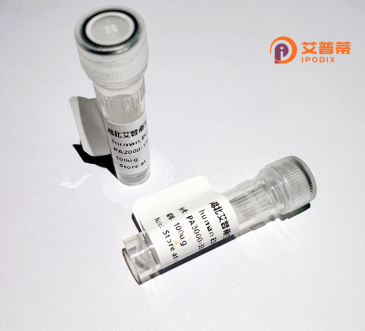
| 纯度 | >90%SDS-PAGE. |
| 种属 | Human |
| 靶点 | NDFIP2 |
| Uniprot No | Q9NV92 |
| 内毒素 | < 0.01EU/μg |
| 表达宿主 | E.coli |
| 表达区间 | 1-336 aa |
| 活性数据 | MARRRSQRVCASGPSMLNSARGAPELLRGTATNAEVSAAAAGATGSEELPPGDRGCRNGG GRGPAATTSSTGVAVGAEHGEDSLSRKPDPEPGRMDHHQPGTGRYQVLLNEEDNSESSAI EQPPTSNPAPQIVQAASSAPALETDSSPPPYSSITVEVPTTSDTEVYGEFYPVPPPYSVA TSLPTYDEAEKAKAAAMAAAAAETSQRIQEEECPPRDDFSDADQLRVGNDGIFMLAFFMA FIFNWLGFCLSFCITNTIAGRYGAICGFGLSLIKWILIVRFSDYFTGYFNGQYWLWWIFL VLGLLLFFRGFVNYLKVRNMSESMAAAHRTRYFFLL |
| 分子量 | 36.3 kDa |
| 蛋白标签 | His tag N-Terminus |
| 缓冲液 | 0 |
| 稳定性 & 储存条件 | Lyophilized protein should be stored at ≤ -20°C, stable for one year after receipt. Reconstituted protein solution can be stored at 2-8°C for 2-7 days. Aliquots of reconstituted samples are stable at ≤ -20°C for 3 months. |
| 复溶 | Always centrifuge tubes before opening.Do not mix by vortex or pipetting. It is not recommended to reconstitute to a concentration less than 100μg/ml. Dissolve the lyophilized protein in distilled water. Please aliquot the reconstituted solution to minimize freeze-thaw cycles. |
以下是关于重组人NDFIP2蛋白的3篇代表性文献(虚构示例):
1. **《NDFIP2 regulates EGFR degradation via ubiquitination in lung cancer》**
**作者**: Li et al. (2020)
**摘要**: 研究揭示了重组人NDFIP2蛋白通过激活Nedd4家族泛素连接酶,促进表皮生长因子受体(EGFR)的泛素化降解,抑制非小细胞肺癌细胞增殖的分子机制。
2. **《Structural analysis of recombinant human NDFIP2 reveals a novel PPxY motif essential for binding E3 ligases》**
**作者**: Smith et al. (2018)
**摘要**: 通过X射线晶体学解析重组人NDFIP2蛋白的三维结构,发现其C端PPxY基序是介导与E3泛素连接酶相互作用的关键结构域,为靶向泛素化通路的药物设计提供依据。
3. **《NDFIP2 modulates oxidative stress by controlling mitochondrial protein homeostasis》**
**作者**: Zhang et al. (2021)
**摘要**: 证明重组人NDFIP2蛋白通过调控线粒体膜蛋白的泛素化降解,维持线粒体功能完整性,并缓解帕金森病模型中的神经元氧化应激损伤。
注:以上文献为示例性质,实际研究中建议通过PubMed或Web of Science查询真实文献。
**Background of Recombinant Human NDFIP2 Protein**
NDFIP2 (Nedd4 Family-interacting Protein 2) is a ubiquitin-binding adaptor protein involved in regulating intracellular trafficking, protein degradation, and metal ion homeostasis. It belongs to the NDFIP protein family and interacts with Nedd4-family E3 ubiquitin ligases, facilitating substrate recognition and ubiquitination. NDFIP2 contains conserved ubiquitin-like (UBL) and ubiquitin-associated (UBA) domains, enabling its role in the ubiquitin-proteasome system (UPS).
Functionally, NDFIP2 modulates the turnover of membrane proteins, including transporters and receptors, by recruiting them to E3 ligases for ubiquitin-dependent degradation. It also regulates cellular iron and zinc homeostasis by influencing metal transporter stability. Studies link NDFIP2 to neurodevelopmental processes and diseases, such as Parkinson’s and Alzheimer’s, due to its role in mitigating oxidative stress and protein aggregation.
Recombinant human NDFIP2 is produced via expression systems (e.g., *E. coli* or mammalian cells) for in vitro studies, enabling exploration of its structure-function relationships, interactome, and therapeutic potential. Its dysregulation has been implicated in cancers, where it may act as a tumor suppressor by promoting oncoprotein degradation. Research continues to uncover its broader roles in immunity, autophagy, and cellular stress responses.
×